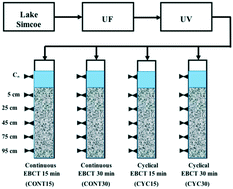MX precursor removal was compared at pilot-scale in continuously and cyclically operated biofilters with empty bed contact times (EBCTs) of 15 and 30 minutes. Water and filter media samples were collected under ambient water quality conditions and during a spike of 7 mg L−1 humic acid (HA). MX formation potential (FP) removals ranged from 26 to 49% and 45 to 61% under ambient precursor and spiked conditions, respectively, suggesting that biofiltration was capable of removing or altering MX precursors. Removal was very strongly correlated (R = 0.90) with ATP (a measure of biomass density) for all trials. MX FP reduction was significantly higher (p < 0.05) with respect to biomass density when comparing cyclically vs. continuously operated filters for all trials. Although lower average ATP concentrations were observed for the cyclically operated filters, these filters achieved a greater MX FP reduction per unit biomass which implies a higher rate of biological function. EBCT did not impact biofilter performance when considering MX FP reduction with respect to either filter depth or biomass density.

